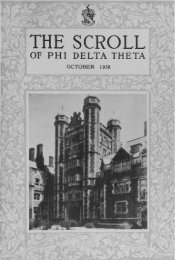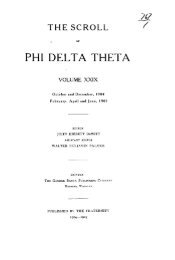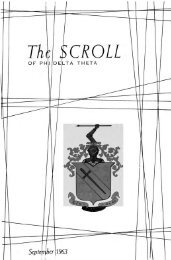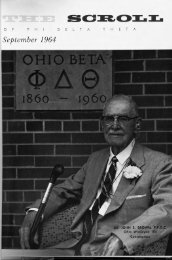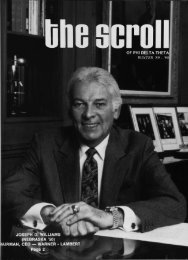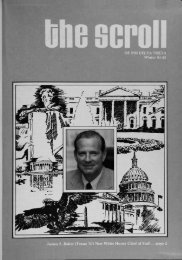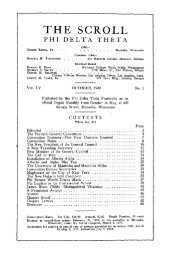1953–54 Volume 78 No 1–5 - Phi Delta Theta Scroll Archive
1953–54 Volume 78 No 1–5 - Phi Delta Theta Scroll Archive
1953–54 Volume 78 No 1–5 - Phi Delta Theta Scroll Archive
Create successful ePaper yourself
Turn your PDF publications into a flip-book with our unique Google optimized e-Paper software.
i84 THE SCROLL of <strong>Phi</strong> <strong>Delta</strong> <strong>Theta</strong> for January, 1954<br />
cut in half. Only by reducing expenses to<br />
the minimum did he. manage to stay in<br />
school, though a Parke-Davis scholarship,<br />
won in 1932, helped save the day by adding<br />
$50 to his monthly stipend. He won his doctorate<br />
in June, 1933, and began work the<br />
same month for Carbide.<br />
Raymond McNamee's first work at the<br />
small Carbide lab was with the synthesis of<br />
materials that were "supposed to revolutionize<br />
the detergent industry."<br />
"Of course the work didn't do that, but it<br />
did bring to light a number of other interesting<br />
things," McNamee says with a grin.<br />
A few years later Dr. McNamee played a<br />
leading role in the study and consequent<br />
development of the process for the direct<br />
oxidation of ethylene to ethylene oxide.<br />
This process had led to enormous expansion<br />
in the production of one of the<br />
most basic synthetic organic chemicals:<br />
ethylene oxide is a starting material for the<br />
manufacture of anti-freezes, lubricants,<br />
plaint, inks and dyes and hundreds of other<br />
products in daily use.<br />
Aided Development of Styrene<br />
He also played a key part in the development<br />
of a process for the manufacture of<br />
styrene, a product and a name well known<br />
to Kanawha Valley people.<br />
This work was in the developmental stage<br />
about the time the German Afrika Korps<br />
was knocking at the gates of Cairo in the<br />
early part of World War II, McNamee recaUed.<br />
Shortly after this, although it generally<br />
wasn't known, America's natural rubber<br />
stocks slipped to 75,000 tons—or about<br />
three weeks' supply.<br />
"By July 4, 1941, our group had turned<br />
out the first gallon of styrene, however," the<br />
chemist said. And when Pearl Harbor came,<br />
the piles had been driven for the first styrene<br />
production on Blaine Island.<br />
When the time of the three-weeks supply<br />
was reached. Carbide had started to produce<br />
polystyrene. Before the famed Institute plan<br />
was finished, too, its capacity had been<br />
boosted from a 3,000,000-pound-per-year<br />
unit to two 25,000,000-pound-per-year units.<br />
Working with dozens of other chemists,<br />
McNamee had raced against time in a dangerous<br />
battle of chemistry and productivity<br />
—and the American team won.<br />
Since the end of the war, much of Dr.<br />
McNamee's time has been spent working<br />
with insecticides. In the case of allethrin,<br />
one of the most significant insecticides to<br />
come out of recent chemical research, he was<br />
directly responsible for the development of<br />
a large-scale production process based on the<br />
original synthesis: by Department of Agriculture<br />
chemists.<br />
This process has greatly amplified the<br />
United States' source of this important, fastacting<br />
insecticide.<br />
When the present Research Center was<br />
completed in 1949, Dr. McNamee was appointed<br />
to head its activities.<br />
A member of the American Chemical Society<br />
since 1932, McNamee served as chairman<br />
of the Kanawha Valley section in 1947.<br />
He is affiliated with the American Institute<br />
of Chemical Engineers, and with 5 S, A X S,<br />
and $AY professional fraternities.<br />
Civic Worker Too<br />
He also takes an active interest in civic<br />
affairs. Last year he was one of the organizers<br />
of the Citizens' Honest Ballot League,<br />
a strong force in the struggle for honest<br />
elections in the county and state.<br />
He's a family man, too. The McNamees<br />
have two sons: Raymond, Jr., an undergraduate<br />
at <strong>No</strong>rthwestern, and <strong>Phi</strong>lip, a Spring<br />
graduate at Charleston High School and covaledictorian<br />
of his class.<br />
If the technical side of Dr. McNamee's<br />
work is confusing to the layman, it might<br />
be fair to note that the youthful chemist<br />
does have his moments of doubt.<br />
When asked about the subject of his dissertation<br />
at <strong>No</strong>rthwestern—the research<br />
problem he worked on in order to qualify<br />
for his Ph.D. degree-Raymond McNamee<br />
was momentarily stumped.<br />
"Oh, yes," he said after a few seconds. "It<br />
was The Rearrangement of Substituted<br />
AUyl Ethers of . . ." At this point he quietly<br />
reached into his desk, pulled out a technical<br />
dictionary, and checked the spelling. ". . . of<br />
'Resorcinol'."<br />
That's Raymond Wilson McNamee, the<br />
fellow who won his first job 20 years ago—<br />
and who has been working at it with outstanding<br />
success ever since.





